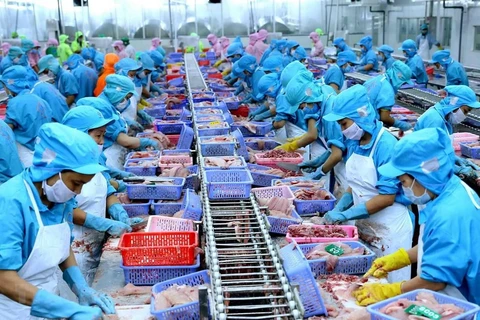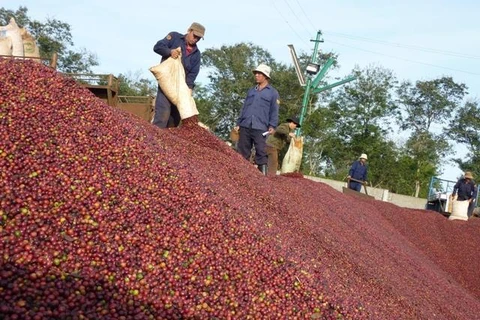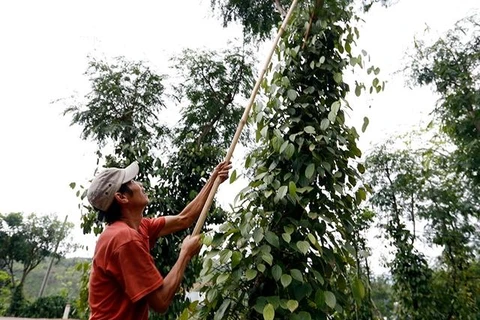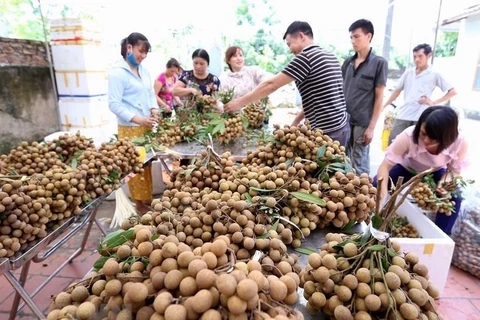 Vietnam posts a year-on-year increase of 8.2 percent in exports between January and September (Photo: VietnamPlus)
Vietnam posts a year-on-year increase of 8.2 percent in exports between January and September (Photo: VietnamPlus) Hanoi (VNA) – Exports by domestic businesses in the first nine months of 2019 grew by 16.4 percent year on year, much faster than the pace seen in the foreign invested sector, according to the Ministry of Industry and Trade (MoIT).
The MoIT said overseas shipments continued to enjoy many positive results despite a downturn in trade and investment activities around the globe.
[Agro-forestry-fishery exports up 2.7 percent in nine months]
Advantages created by trade agreements
The ministry reported that the nine-month exports reached 194.3 billion USD, up 8.2 percent from the same period last year.
Notably, shipments have risen quarter by quarter: up 5.3 percent in Q1, 7.2 percent in Q2, and 8.2 percent in Q3, compared to the target of 7 – 8 percent for the whole 2019.
An MoIT representative noted the participation in free trade agreements (FTAs) which include members’ commitments to reducing tariffs on goods of Vietnamese origin has helped improve Vietnamese products’ competitiveness and expand their presence in those markets.
Statistics show that in the nine months, exports to Russia climbed by 13.9 percent, Japan 10 percent, the Republic of Korea 8.1 percent, and members of the Association of Southeast Asian Nations (ASEAN) 4.7 percent. In particular, good growth was also recorded in exports to members of the Comprehensive and Progressive Agreement for Trans-Pacific Partnership (CPTPP), such as Canada 2.9 billion USD (up 30.9 percent) and Mexico 2.2 billion USD (27 percent).
Meanwhile, goods shipped to the US brought home 44.86 billion USD during the period, up 28.2 percent year on year.
Exports by the domestic economic sector expanded by 16.4 percent in the past three quarters, a pace much faster than the 5-percent increase in the foreign invested sector. Thanks to this, domestic firm’s proportion in total exports continued to grow, accounting for 30.7 percent, while the figure last year was 28.5 percent.
However, unlike previous years, momentum for the domestic sector’s exports growth so far this year did not come from agricultural and aquatic products, but items of the industrial sector. While shipments of agricultural and aquatic products fell 5.7 percent year on year, exports of processed goods picked up 10.3 percent, thus contributing to overall growth.
Local businesses performed well in the export of many commodities like timber, wood items, textile – garment, and plastic and rubber products.
This fact shows that efforts to improve the investment – business climate and integrate into the global economy have really facilitated enterprises’ production and business activities, especially industrial manufacturing, according to the MoIT.
Sustaining exports growth
In the meantime, imports during the last nine months reached 188.42 billion USD, up 8.9 percent from the same period last year. The sum included 109.4 billion USD by foreign invested companies and 78.97 billion USD by domestic firms.
About 166 billion USD worth of necessary commodities were imported, rising by 7.8 percent year on year and making up 88.1 percent of the total import revenue. Among these items, the most imported were computers, electronic products and components, worth 38.65 billion USD, increasing by 23 percent.
Imports of machinery, equipment and spare parts also jumped 13.1 percent, fabric 3.2 percent, and plastic products 10.7 percent.
As a result, Vietnam still maintained trade surplus, at 5.9 billion USD, in the January – September period.
 The processing – manufacturing industry is a large contributor to exports growth (Photo: VietnamPlus)
The processing – manufacturing industry is a large contributor to exports growth (Photo: VietnamPlus) The MoIT predicted exports will keep growing in the remaining months of 2019, fuelled by traditional items like textile – garment, footwear and wood products. Additionally, shipments usually surge in the final months of a year as this is the peak shopping season to prepare for holidays.
The ministry said to support export activities in the coming peak period, it has been assisting businesses to capitalise on chances generated by FTAs and actively carry out solutions to boost overseas shipments.
To agro-forestry-fishery products, Minister Tran Tuan Anh said the MoIT will coordinate with relevant ministries and sectors to support major farming and exporting localities so as to meet foreign markets’ demand and improve export efficiency.
Besides, it will also help domestic companies to improve their production capacity and take part in supply chains of foreign businesses, while taking measures to address export difficulties, he added./.

























